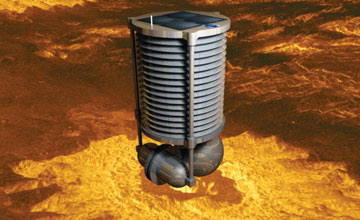|
FEATURE
Venturing to Venus
Erin Wayman
Viewing Venus:
Highlights in exploring Earth's twin Print Exclusive
Venus’ Strange Spin Print Exclusive
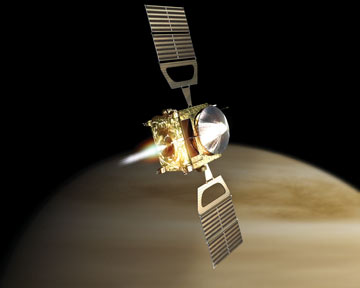 ESA - AOES Medialab |
| An artist's rendering of the Venus Express. |
In the twilight sky, low on the horizon, glows a brilliant body. Occasionally mistaken for a UFO, the planet is actually our nearest neighbor and Earth’s twin: Venus. Earth and Venus share a similar mass, volume and distance from the sun. Scientists even think the two planets were birthed from the same parent material some 4.5 billion years ago. But while Earth was developing into a thriving planet filled with life, Venus went down a wayward path, becoming Earth’s “evil” twin: a hellishly hot world enveloped by a thick, toxic atmosphere. “It’s like having two chocolate cake mixes and one comes out a lemon cake,” says Ellen Stofan, a Venus researcher at Proxemy Research, Inc. in Laytonsville, Md.
Exactly how and why Earth and Venus diverged is a nagging question that scientists can’t yet answer. But by learning more about Venus and its evolution, scientists say they can better understand the geological and climatic processes that affect Earth and predict what’s in store for the planet in the future. Solving the mysteries of Earth’s nearest neighbor, however, will only be possible with the help of more data, and the only way to gather more data is to send new, more sophisticated missions to explore Venus.
The United States has not sent a dedicated mission to Venus in almost 20 years and doesn’t have any definite plans to do so in the future. “It’s an easy place to get to,” says Kevin Baines, a planetary scientist at NASA’s Jet Propulsion Laboratory (JPL) in Pasadena, Calif., “but America has ignored it.” Fortunately for Venus researchers, the Europeans and Japanese have not. In 2005, the European Space Agency launched Venus Express, an orbiting satellite designed to study Venus’ atmosphere and climate. The Japan Aerospace Exploration Agency will follow suit in 2010 when it sends its own Venus Climate Orbiter “Planet-C” into space.
Although these missions are important, scientists say more are needed and that now is the time for the United States to get back in the game. American researchers hope to seize opportunities this year that may allow them to make missions to Venus a reality within the next decade — missions that could send spacecrafts to Venus’ lower atmosphere and perhaps even the Venusian surface.
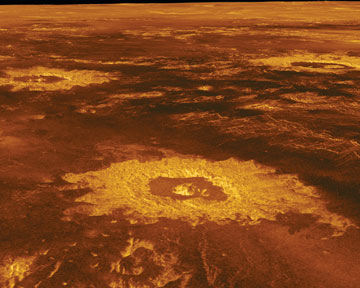 NASA/JPL |
| Impact craters are evenly distributed across Venus. |
“Venus is a place we’ve looked at fleetingly,” says Stephen Mackwell, director of the Lunar and Planetary Institute in Houston, Texas. “You’ve got to wonder what we’d learn if we took a closer look.”
Early exploration
Before the first spacecraft reached Venus in the early 1960s, scientists thought the planet would be a pleasant place to visit with a warm climate reminiscent of Miami, Fla., Baines says. They had reasoned that even though Venus is closer to the sun than Earth is — and therefore should be hotter — its dense white cloud cover probably prevents much sunlight from reaching the surface. Those two factors would make Venus warm, but not scorching.
In 1962, NASA’s Mariner 2 became the first spacecraft to fly by Venus, and the information it sent back to Earth showed just how wrong scientists had been. The average surface temperature on Venus is 460 degrees Celsius — hot enough to melt lead — and subsequent missions showed the planet has an incredibly high, crushing surface pressure, equivalent to the intense pressures found hundreds of meters below Earth’s oceans. “Venus went from a nice balmy place to literally being hell,” Baines says.
During the 1960s and 1970s, the Soviet Union dominated much of the early exploration of Venus with a series of 16 missions with “Venera” spacecraft. In 1970, Venera 7 became the first spacecraft to land on Venus and send data back to Earth. But the lander was not prepared for Venus’ harsh environment and melted after just 23 minutes. Five years later, Venera 9 outlasted its predecessor by half an hour and transmitted the first photos of Venus’ surface back to Earth.
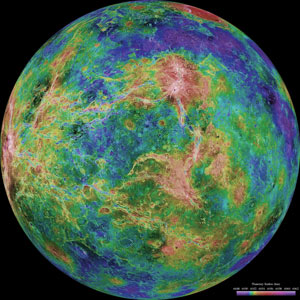 NASA/JPL |
| This topographic map of Venus was created from radar data collected by the Magellan spacecraft. |
By the late 1970s, NASA returned to Venus and focused much attention on mapping the planet’s surface. This proved to be a tricky endeavor. Venus has “a very thick atmosphere that obscures its surface, so you can’t take pictures of it from orbit like you can for Mars, the moon or Earth,” says James Cutts, chief technologist at JPL's Solar System Exploration Programs Directorate. Yet radar can penetrate the atmosphere, and in 1978 NASA sent the Pioneer Venus Orbiter to map parts of the planet. In 1989, NASA’s Magellan spacecraft made the most detailed map of Venus to date, Stofan says, covering 98 percent of the planet’s surface and giving researchers a rough sense of Venus’ topography.
These and other Venus missions gave researchers a taste of the many ways Earth differs from its twin. The photos and radar maps indicate Venus' surface is mostly solid basalt similar to that found at Earth’s mid-ocean ridges, Mackwell says, with little to no signs of erosion. But the greater surface density on Venus would make visitors feel like they were wading through the ocean rather than walking on dry land. The planet hosts mountains as tall as the Himalayas, but most of Venus’ surface is low volcanic plains. Magellan also revealed unusual volcanic domes shaped like pancakes. Although volcanism was clearly active on the planet at some point, researchers only have indirect evidence, such as sulfuric acid in the atmosphere, that volcanic activity continues on Venus today.
Scientists know even less about Venus’ interior. Because Earth and Venus share a similar size and shape, researchers assume they probably have similar interior structures of crust, mantle and core. But unlike Earth, which generates a magnetic field from within its core that shields the planet from harsh solar winds, Venus has only a very small, weak magnetic field.
Tantalizing Clues
After more than three decades of probing Venus, researchers have been left with as many questions as answers. For example, the Magellan mission showed that craters on Venus are evenly distributed across the planet. Most rocky bodies in the solar system, however, have a variable distribution — some areas have a lot of craters, others only a few. Researchers think the heavily cratered areas are older than the sparsely cratered regions, because they must have been around longer to accumulate the many impacts. Venus’ pattern, in contrast, suggests the entire surface is of the same age. In fact, researchers think that the planet’s surface is quite young and may have been completely resurfaced at some point within the last billion years, Mackwell says.
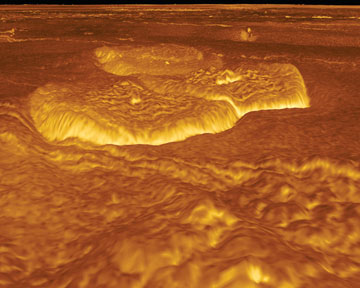 NASA/JPL |
| Most of Venus' surface is low volcanic plains, but it also has pancake-shaped volcanic domes like this one. |
How and why this could have happened is not yet known, but some blame the planet’s lack of plate tectonics. On Earth, the movement of the plates helps release some of the heat from inside the planet’s fiery interior. On Venus, the lack of plate tectonics may have led to a buildup of so much heat inside the planet that the surface collapsed: The crust became so weak that it became vulnerable to widespread foundering.
Finding clues to this and other pressing geological questions about Venus and its evolution, such as whether plate tectonics were ever active, is difficult. “It’s tough to look for old bits on the surface,” Mackwell says. “All we have are orbital satellites that use radar frequencies,” which say nothing about geochemistry, a rock’s age or the planet’s composition. “It’s hard to peel back the history of a planet when you’ve got so little to go on,” he says.
But researchers do have some clues that Venus may have been more similar to Earth during its youth. By analyzing certain heavy isotopes of hydrogen in Venus’ atmosphere, researchers know the planet was once home to significant amounts of water and probably once housed an ocean that lasted at least a billion years. Today, the planet is virtually free of water, so scientists are eager to learn if it was indeed a much wetter place in the past, and if so, what happened. Baines suggests Venus’ lack of water may be due to the fact that the planet has no significant magnetic field, which may allow hydrogen to leak out of the planet’s atmosphere: Water molecules that wander into the upper atmosphere and are broken down into hydrogen and oxygen by powerful ultraviolet sunlight, and then solar winds — untempered by a powerful magnetic field as on Earth — pull away the lighter hydrogen atoms while leaving behind the oxygen. Eventually, the leaking hydrogen may have drained Venus of the majority of its water. That could also explain the lack of plate tectonics on Venus today, Baines says, because water acts as a lubricant for the moving plates.
The missing magnetic field could be responsible for Venus’ hot temperatures too. With Venus losing its hydrogen, the free oxygen in the atmosphere could bind with carbon, creating carbon dioxide. Venus’ atmosphere is about 96 percent carbon dioxide (Earth’s atmosphere, in contrast, is less than 1 percent carbon dioxide), giving Venus “the mother of all greenhouse effects,” Cutts says. In fact, it was by studying how carbon dioxide traps and absorbs heat on Venus that scientists such as Carl Sagan first understood the greenhouse effect and how it works on Earth, Baines says. Studying Venus has also given researchers insight into how Earth’s ozone layer works, he adds: “Venus has taught us a lot about our planet,” and it still has a lot left to offer.
Return to Venus
In 2005, NASA sought proposals for exploratory missions to five destinations in the solar system under its New Frontiers Program, which funds “medium-class” missions that cost less than $800 million. NASA chose the locations, including Venus, based on recommendations in the National Research Council’s Solar System Exploration Decadal Survey (2003 to 2013). A mission to Jupiter won the funding, but Venus researchers are already preparing for NASA to announce the details of the next round of New Frontiers funding sometime later this year. A “Venus mission is a prime candidate,” Cutts says.
|
| An artist's conception of a future mobile explorer on Venus (above) and the Venus In-Situ Explorer (below). |
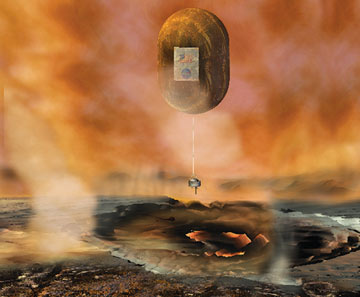 NASA |
In 2005, NASA also formed the Venus Exploration Analysis Group (VEXAG) to outline scientific goals and priorities for future missions to the planet. Consisting of Venus researchers from around the United States, VEXAG met most recently last October. The group identified three broad themes that should be central to any future missions: the origin and evolution of Venus, the geological and climatic processes that still affect the planet and what Venus may say about the future of Earth. They also outlined the various observations, measurements and technologies needed to further understanding in these areas.
For atmospheric researchers, one of the top priorities is to investigate the chemistry of the atmosphere more closely. In particular, measuring Venus’ noble gases will help scientists learn more about the planet’s origin and evolution. Because noble gases don’t react or combine with other elements, the ratio of noble gases present in Venus’ atmosphere today should be representative of its earliest atmosphere and the material from which the planet formed, Baines says. Cataclysmic events like impacts also leave their mark in a planet’s noble gas record, he says. But measuring noble gases will require sending a probe directly into the atmosphere because noble gases do not emit unique spectral signatures that can be detected from a satellite orbiting the planet.
What planetary geologists really crave is a return to the surface, Stofan says. A surface probe could assess the geochemical and mineralogical characteristics of surface sediments, like the rovers are doing on Mars. Further into the future, some researchers envision establishing a network of seismometers on Venus to assess its seismic activity, she says, or using seismology and ground-penetrating radar to view the internal structure of the planet, Mackwell says.
But before any probe enters Venus’ atmosphere or lands on its surface again, several technical challenges need to be addressed — especially the planet’s metal-melting temperatures. “The big issue is the temperature because it’s a lot harder to cool things down than to heat things up,” Cutts says. Communication and computer electronics aren’t designed to work at Venus’ high temperatures, so a system of passive cooling — akin to packing a cooler with ice — could extend the lifetime of a mission by days, he says, which is something NASA is “very close to being able to do.” But achieving a long-term mission on Venus will require developing a way to keep a spacecraft cool by pumping out the heat — an achievement not likely in the immediate future, he adds.
Despite its extreme environment, not everything is a challenge when it comes to exploring Venus. “It’s close to Earth, a little easier to get to than Mars,” Cutts says. And he notes that Venus’ thick atmosphere actually makes it easier for a spacecraft to land on the surface because it slows down vehicles as they descend, allowing for gentler landings that require less active navigation than a spacecraft landing on Mars would need, for example.
 ESA (image by Christopher Carreau) |
| Instruments aboard the Venus Express have detected evidence of lightning on Venus. |
The most likely next NASA mission to Venus would consist of sending a large balloon into the Venus atmosphere equipped with instruments to measure properties of both the atmosphere and surface. During the last round of New Frontiers funding, NASA requested proposals for such a mission, called the Venus In-Situ Explorer. This would not be the first balloon mission on Venus, however. In 1984, the Soviet Union released two balloons — Vega 1 and Vega 2 — into the Venusian atmosphere, approximately 50 kilometers above the surface. At that height, the temperature and pressure conditions are much closer to those on Earth, Cutts says. A new balloon mission could be more successful than the Soviet balloons, because researchers now have better electronics and instrumentation to explore the planet, Mackwell says. And the advantage of a balloon is that it could survive much longer — days or weeks — than a probe on the surface and could use Venus’ strong winds to power its journey, Baines says. It could also be designed to descend to the ground periodically to collect surface samples that could then be analyzed in the atmosphere to limit the probe's exposure to heat and pressure, Stofan says.
A successful balloon mission could pave the way for a mobile explorer on Venus. Unlike the Mars rovers, a mobile vehicle on Venus would probably not have wheels, Cutts says. Instead, because the lower atmosphere is so dense, such a vehicle might rely on a metallic balloon to lift it off the ground and then use its buoyancy to float through the air near the Venus surface, similar to an airboat. This would also allow the vehicle to travel farther distances across the Venus terrain, Mackwell says, which is important because researchers don’t yet know how far a vehicle would need to travel to encounter enough features to get a representative view of Venus.
To prepare for the imminent New Frontiers announcement, VEXAG is meeting again this month to discuss new advancements in Venus science research and further refine exploration goals and priorities. “There’s a lot to learn there,” Mackwell says. “It’s a very tricky planet.” Venus researchers are keeping their fingers crossed that this will be the year Venus makes the final cut.

 Subscribe
Subscribe

